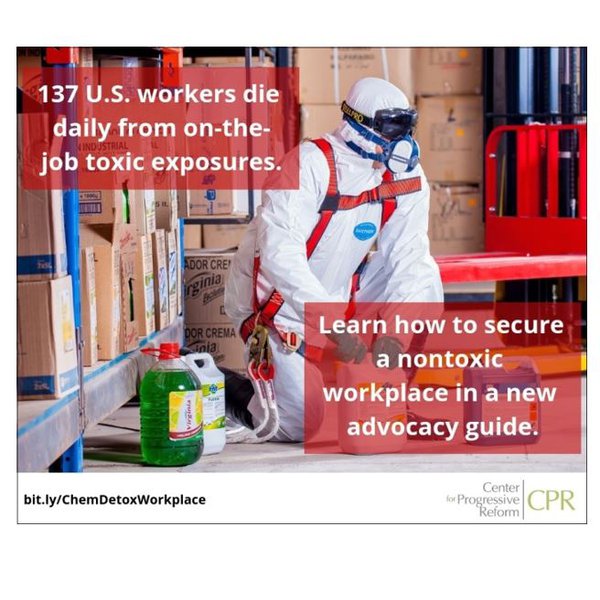Workers should be able to earn a paycheck without putting their lives or their health and well-being on the line. Yet every day, an estimated 137 U.S. workers succumb to diseases caused by on-the-job exposure to toxic chemicals and other hazardous substances, and hundreds of thousands more suffer from nonfatal illnesses. In fact, more people die annually from toxic exposures at work than from car crashes, firearms, or opioids.
Today, the Center for Progressive Reform (CPR) releases a new handbook, Chemical Detox for the Workplace: A Guide to Securing a Nontoxic Work Environment, exploring multiple strategies that workers, their representatives, and advocates can implement to reduce or eliminate chemical hazards in their workplaces and assist injured workers, all without waiting for government intervention. This is critically important now more than ever as the Trump administration and the chemical industry fight aggressively to undermine existing protections and stall new ones.
Weak and outdated chemical exposure standards for the workplace have long been a challenge for workers, but the Trump administration has actively sought to make a bad problem worse. Some of Trump's first acts as president were to delay enforcement of the Occupational Safety and Health Administration's (OSHA) newest chemical exposure limits for silica dust and beryllium and subsequently to propose easing requirements in the beryllium standard for the maritime and construction industries. OSHA has also abandoned the development of limits on exposure to the organic solvent 1-brompropane and the industrial chemical styrene, both of which cause neurological damage and may cause cancer. Trump has also repeatedly proposed slashing the Department of Labor's budget and eliminating the Chemical Safety Board, the independent federal agency that investigates major industrial chemical incidents.
Operations have fared even worse at the Environmental Protection Agency (EPA), which is charged with implementing the 2016 update to the Toxic Substances Control Act (TSCA). Under TSCA, EPA must perform risk evaluations of high-priority chemicals and then issue standards to manage the risks those chemicals pose to human health, including to workers, and the environment. Yet Trump appointed a chemical industry lobbyist straight from the American Chemistry Council, a chemical industry trade group, to serve as the Principal Deputy Assistant Administrator of EPA's Office of Chemical Safety and Pollution Prevention (OCSPP), the office tasked with performing EPA's work under TSCA and other federal environmental laws addressing toxic substances. Not coincidentally, since Trump took office, EPA has allowed new chemicals onto the market despite significant risks to workers and has halted its own proposed ban on the commercial use of methylene chloride.
The risks posed by toxic substances at work are too great to ignore. Chemical hazards lurk at virtually every worksite imaginable, including in sectors like agriculture, domestic cleaning, nail salons, disaster response, and chemical manufacturing.
CPR's new guide provides workers, their representatives, and advocates with resources to learn about chemical hazards and tactics for addressing exposures in the workplace. Some of the strategies explored in the manual include working with an employer to utilize safer alternatives, filing a complaint with OSHA or submitting a tip to EPA, suing low-road employers using "citizen suit" provisions in federal environmental laws or by filing a toxic tort lawsuit, and advocating beyond the workplace. Our hope is that this guide will help workers take action to secure a nontoxic work environment even if the Trump administration continues to shirk its responsibilities.
To learn more, check out the report and tune in for a webinar on Wednesday, May 8 at 1 p.m. Eastern. You can register by clicking here.
Share this report
You can retweet this report by clicking here. You can also visit our Facebook page and share it there.

